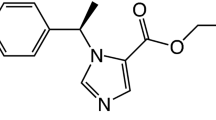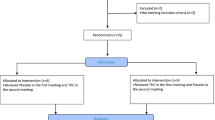Abstract
Forskolin, a diterpene isolated from the plant Coleus forskolii, activates the catalytic subunit of adenylate cyclase, resulting in a hormone receptor-independent increase in the intracellular production of cyclic AMP. This study was undertaken to assess the effect of chronic in vivo infusion of forskolin on noradrenergic neuronal activity. Forskolin was infused into the right lateral ventricle of male Sprague Dawley rats via Alzet osmotic minipumps (model 2001) for 7 days. Chronic infusion of forskolin resulted in a decrease in norepinephrine-stimulated cyclic AMP accumulation in the limbic forebrain. Chronic infusion of forskolin also resulted in a decrease in the Bmax for 3H-dihydroalprenolol (3H-DHA) binding to beta-adrenergic receptors in the cerebral cortex and hippocampus, with no apparent change in the Kd values. These data suggest the possibility of a novel therapeutic approach to modulating receptor sensitivity, and that chronic infusion of forskolin may be a useful model for studying the role of cyclic AMP in the control of neuronal activity.
Similar content being viewed by others
References
Bhat SV, Bajwa BS, Dornayer H, DeSouza NJ (1977) Structures and stereochemistry of new labdane diterpenoids from Coleus forskohlill briq. Tetrahedron Lett 19:1669–1672
Bradford MM (1976) A rapid and sensitive method for the quantification of microgram quantities of protein using the principle of protein dye binding. Anal Biochem 72:248–260
Dolphin A, Adrien J, Hamon M, Bockaert J (1979) Identity of 3H-dihydroalprenolol binding sites and beta-adrenergic receptors coupled with adenylate cyclase in the CNS: Pharmacological properties, distribution, and adaptive responsiveness. Mol Pharmacol 15:1–15
Katz IR, Smith D, Makman MH (1983) Forskolin stimulates the conversion of tyrosine to dopamine in catacholamine neuronal tissue. Brain Res 264:173–177
Mobley PL, Manier DH, Sulser F (1983) Norepinephrine-sensitive adenylate cyclase system in rat brain: Role of adrenal corticosteriods. J Pharmacol Exp Ther 226:71–77
Seamon KB, Daly JW (1981) Forskolin: A unique diterpene activator of cyclic AMP-generating systems. J Cyclic Nucl Res 7:201–206
Seamon KB, Daly JW (1983) Forskolin, cyclic AMP, and cellular physiology. TIPS 7:210–215
Stadel JN, Nambi P, Shorr RGL, Sawyer DF, Caron MG, Lefkowitz RJ (1983) Catecholamine-induced desensitization of turkey erythocyte adenylate cyclase is associated with phosphorylation of the beta-adrenergic receptor. Proc Natl Acad Sci (USA) 80:3173–3182
Sulser F, Mobley PL (1981) Regulation of central noradrenergic receptor function: New vistas on the mode of action of antidepressants. In: Neuroreceptors: Basic and clinical aspects, Raven Press, New York, pp 312–322
Watson EL, Dowd FJ (1983) Forskolin: Effects on mouse parotid gland function. Biochem Biophys Res Commun 21:111–117
Author information
Authors and Affiliations
Rights and permissions
About this article
Cite this article
Suzdak, P.D., Browne, R.G. The effect of chronic in vivo infusion of forskolin on noradrenergic receptor sensitivity. Psychopharmacology 87, 464–467 (1985). https://doi.org/10.1007/BF00432514
Received:
Accepted:
Issue Date:
DOI: https://doi.org/10.1007/BF00432514




